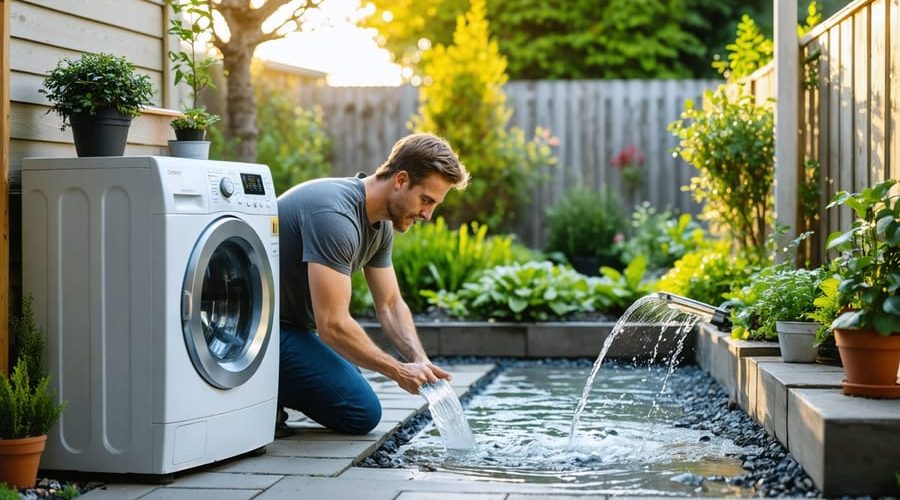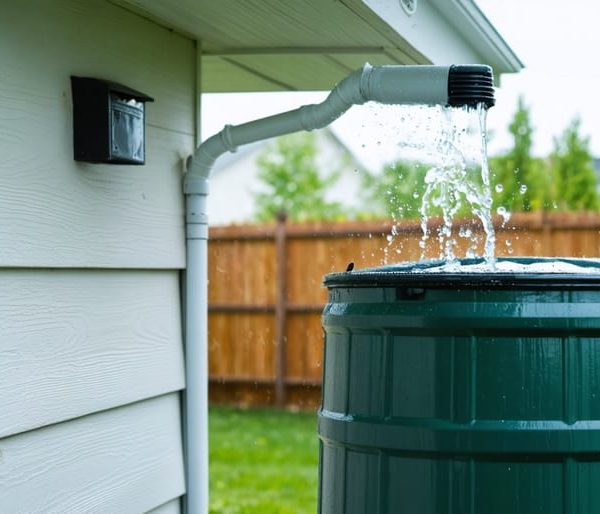**Reduce your household water consumption by 30-50% by capturing and reusing water from your sinks, showers, and washing machines—water that currently flows straight down the drain.** Every day, the average home sends thousands of gallons of lightly-used “gray water” into the sewer system, even though this resource could irrigate gardens, flush toilets, or support other non-potable uses.
Gray water recycling systems intercept this discarded water before it leaves your home, filter out contaminants, and redirect it for beneficial purposes. Unlike blackwater from toilets, gray water contains minimal pollutants and requires only basic treatment for safe reuse. Modern systems range from simple gravity-fed garden irrigation setups costing a few hundred dollars to sophisticated whole-house installations with advanced filtration and automated distribution networks.
**The environmental impact extends beyond water conservation.** By recycling gray water, you’ll reduce strain on municipal water treatment facilities, lower energy consumption associated with water heating and pumping, and decrease your utility bills substantially. In drought-prone regions, these systems provide crucial resilience when water restrictions limit outdoor irrigation or supply concerns arise.
Whether you’re motivated by environmental stewardship, cost savings, or water security, understanding gray water systems empowers you to make informed decisions about implementation. This guide demystifies the technology, explores system options for different budgets and needs, and walks you through the practical considerations—from local regulations to installation requirements—that determine whether gray water recycling makes sense for your home.
What Is Greywater and Why Should You Care?
The Difference Between Greywater and Blackwater
Understanding the difference between greywater and blackwater is fundamental to safely implementing any water recycling system in your home. Greywater refers to gently used water from your bathroom sinks, showers, bathtubs, and washing machines—essentially any household water that hasn’t come into contact with toilet waste. This water contains traces of soap, shampoo, food particles, and dirt, but remains relatively clean and safe for reuse with proper treatment.
Blackwater, on the other hand, comes from toilets and kitchen sinks (due to raw food contamination), containing human waste, harmful bacteria, and pathogens that require extensive treatment before any reuse. Blackwater systems demand far more sophisticated purification processes and typically aren’t suitable for residential recycling.
This distinction matters enormously for your safety and the practicality of home water recycling. Greywater can be treated with simpler filtration methods and safely reused for irrigation, toilet flushing, and even laundry with appropriate systems. Because it contains fewer contaminants, it poses minimal health risks when handled correctly. Most residential greywater systems focus exclusively on capturing and treating this gentler wastewater stream, making them more affordable, easier to maintain, and safer for homeowners to operate without specialized expertise.
Common Greywater Sources in Your Home
Not all household wastewater is suitable for recycling. Understanding which sources are safe for greywater systems helps you maximize water savings while protecting your family and landscape.
**Safe Greywater Sources:**
Your shower and bathtub produce the largest volume of reusable water in most homes. This water typically contains only soap, shampoo, and skin oils, making it ideal for irrigation once it cools down. Bathroom sink water follows similar characteristics and works well in greywater systems.
Washing machines generate substantial greywater, though you’ll want to use plant-friendly, biodegradable detergents without bleach or boron. Many modern systems tap directly into laundry drains for easy collection.
**Sources to Avoid:**
Kitchen sinks contain food particles, grease, and oils that can harm plants and clog systems. Dishwasher water runs too hot and contains harsh chemicals unsuitable for irrigation.
Never include toilet water—that’s blackwater requiring separate treatment. Also avoid water from washing diapers or cleaning up after illness, as these may contain harmful pathogens.
The key is identifying “lightly soiled” water sources. If you wouldn’t feel comfortable touching the water briefly, it probably doesn’t belong in your greywater system. This simple rule keeps your recycling efforts both safe and effective.
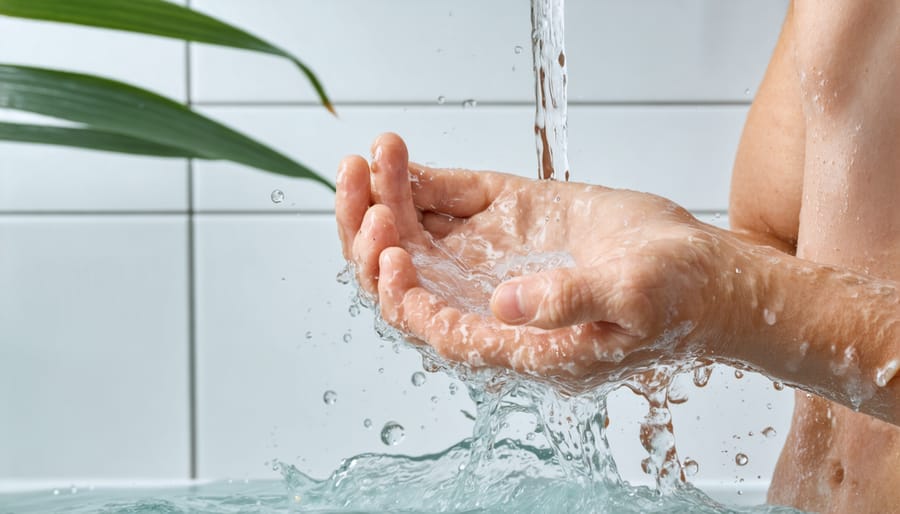
How Greywater Recycling Systems Actually Work
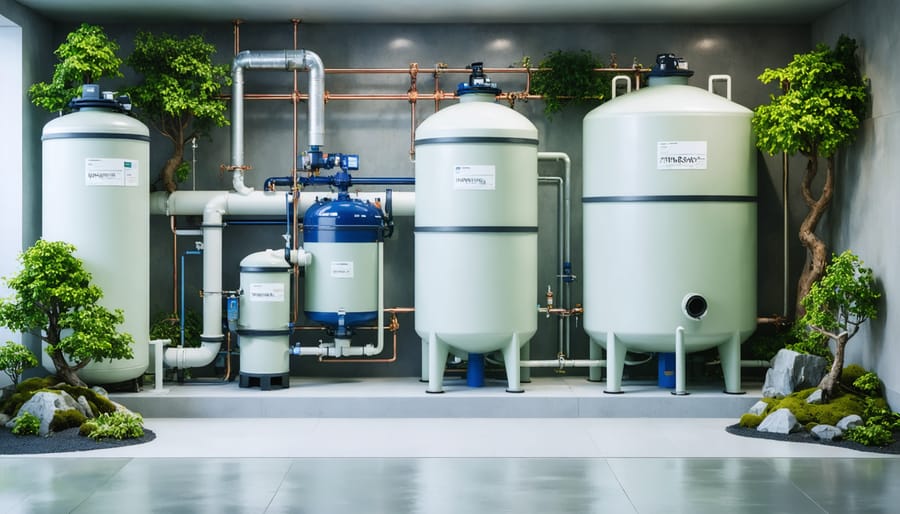
Collection: Capturing Water Before It Goes to Waste
The beauty of greywater recycling lies in its simplicity—you’re essentially redirecting water that’s already flowing through your home. Instead of allowing used water from your washing machine, bathroom sinks, and shower to disappear down the drain into the sewer system, strategic plumbing modifications capture it for beneficial reuse.
The collection process begins at the source. Greywater systems use diverter valves or three-way plumbing fixtures installed at key drain points throughout your home. These modifications create a fork in the road for your wastewater—sending it either to the greywater system or to the traditional sewer line when needed. Think of it as adding a second pathway that gives your used water a chance at a second life.
For most homeowners, the laundry machine serves as the ideal starting point. It’s typically the easiest source to tap into and produces substantial volumes of relatively clean greywater. A simple diverter valve can be installed on the washing machine’s discharge hose without major renovations. Bathroom fixtures like showers and sinks require slightly more involved plumbing work, as collection pipes need to be separated from toilet wastewater (blackwater), which must never enter a greywater system due to health concerns.
Treatment: Making Greywater Safe for Reuse
Making greywater safe for reuse doesn’t require a chemistry degree—just a few straightforward treatment steps that remove contaminants and protect your home and garden.
The treatment process typically begins with **filtration**, the first line of defense against debris. A simple mesh filter or screen catches hair, lint, and larger particles before they enter your system. Think of it like a coffee filter for your water—it’s a physical barrier that stops the visible stuff. Many systems use multi-stage filtration, starting with coarse filters and progressing to finer ones, similar to the variety of water filtration options used for drinking water.
Next comes **settling**, where gravity does the heavy lifting. In a settling tank, water sits quietly for a period, allowing suspended particles and sediment to sink to the bottom. This natural process clarifies the water without chemicals or complex equipment.
Some systems incorporate **biological treatment**, where beneficial bacteria break down soap residues and organic matter. These microorganisms work like nature’s cleanup crew, consuming contaminants and transforming them into harmless substances. This eco-friendly approach mimics natural processes found in wetlands and soil.
For enhanced safety, especially when reusing greywater for edible gardens, **disinfection** provides an extra layer of protection. UV light systems or chlorine tablets can eliminate remaining bacteria, though this step isn’t always necessary for ornamental landscape irrigation where water doesn’t contact consumable plant parts.
Distribution: Getting Recycled Water Where You Need It
Once your greywater is treated, you’ll need an effective way to distribute it throughout your home. Most systems include a storage tank that holds cleaned water until you’re ready to use it—typically ranging from 50 to 200 gallons depending on your household size and needs.
The most popular application is outdoor irrigation, where greywater flows through drip lines or subsurface irrigation systems to water your lawn, garden, or landscaping. This approach keeps the water below ground level, maximizing plant absorption while minimizing human contact. Modern distribution systems use simple valves and timers to automate watering schedules, making the process completely hands-off.
Indoor toilet flushing represents another practical use, accounting for roughly 30% of household water consumption. In this setup, treated greywater connects to a separate plumbing line that feeds your toilets, reducing your reliance on fresh drinking water for flushing. Some cutting-edge systems even include dual storage—one tank for irrigation and another for toilet supply—giving you flexibility based on seasonal needs and usage patterns.
Types of Greywater Systems for Every Home and Budget
Simple Direct-to-Landscape Systems
If you’re new to greywater recycling, a simple direct-to-landscape system offers the perfect starting point. These straightforward setups redirect water from a single source—typically your washing machine or bathroom sink—directly to your garden or landscaping through basic piping. No pumps, filters, or complex technology required.
Here’s what makes this approach so accessible: you’re essentially creating a gravity-fed pathway from your greywater source to thirsty plants. The water flows through standard pipes into a mulch basin around trees, shrubs, or other outdoor vegetation. The mulch acts as a natural filter while the soil does the heavy lifting of purification. This eco-friendly solution can be installed in a weekend with basic plumbing skills and costs just a few hundred dollars in materials.
The system works best with drip irrigation systems or subsurface distribution to ensure water reaches plant roots without pooling on the surface. You’ll want to use biodegradable, plant-friendly soaps and avoid sending water to edible gardens—ornamental plants and trees are ideal candidates.
This entry-level option lets you divert 15-40 gallons per laundry load, making an immediate impact on your outdoor water consumption while you learn the basics of greywater management.
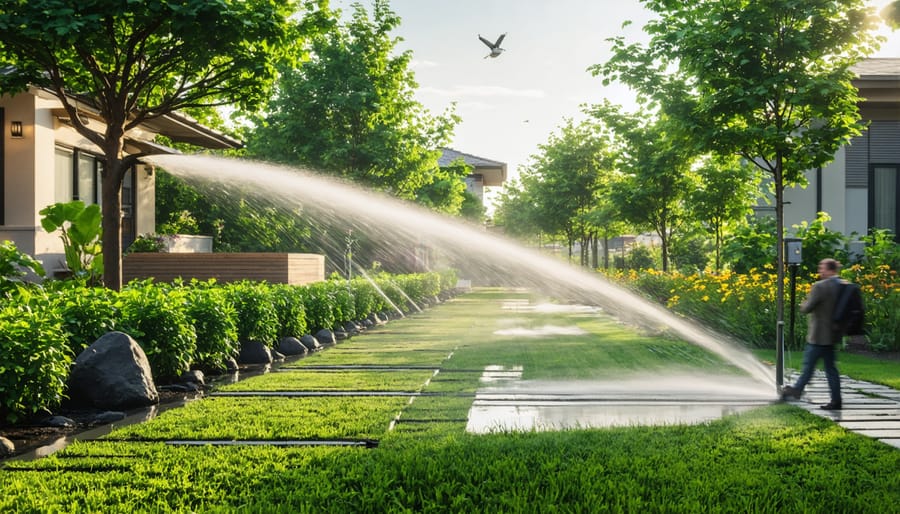
Branched Drain Systems
Branched drain systems represent a practical middle ground for homeowners wanting to recycle greywater without investing in expensive pumps or complex filtration equipment. This gravity-powered approach channels water from your washing machine or bathroom sinks through a network of split pipes that divide the flow evenly between multiple irrigation zones in your landscape.
The beauty of branched drain systems lies in their simplicity. Water flows downhill through progressively smaller pipes that branch like tree limbs, distributing greywater to different garden beds or plant groups. Each junction typically splits the flow 50-50, allowing you to water up to eight different areas from a single greywater source. The system requires minimal maintenance—just occasional flushing of the pipes and monitoring to ensure even distribution.
Installation costs range from $500 to $2,000 depending on your yard’s layout, making this an affordable entry point into greywater recycling. You’ll need to use biodegradable, plant-friendly soaps and detergents since the water receives no treatment before reaching your plants. This system works best on relatively flat terrain where you can maintain proper downward slopes, and it’s ideal for irrigating fruit trees, ornamental plants, and established landscaping that can handle fluctuating water volumes.
Automated Treatment and Reuse Systems
For homeowners seeking a comprehensive solution, automated gray water systems represent the cutting edge of residential water recycling. These whole-house systems integrate directly into your home’s plumbing infrastructure, automatically collecting, treating, and redistributing gray water without requiring daily manual intervention.
At the heart of these systems lies a multi-stage filtration process. Gray water first passes through screens that remove hair, lint, and solid particles, then moves through biological or advanced mechanical filters that eliminate bacteria and organic matter. The treated water collects in storage tanks—typically ranging from 50 to 400 gallons—before being pumped to designated end-uses.
What sets automated systems apart is their smart distribution capability. Programmable controllers monitor water quality, manage storage levels, and distribute treated gray water to irrigation zones, toilet flushing, or laundry machines based on your household’s patterns. Some advanced models even include sensors that detect when gray water quality drops below standards, automatically switching to fresh water to maintain safety.
Installation requires professional expertise and investment ranging from $5,000 to $15,000, but these systems can reduce household water consumption by 30-50%. They’re particularly valuable in drought-prone regions or for larger homes with substantial landscaping needs, transforming an environmental aspiration into an effortless daily reality.
The Real Benefits: More Than Just Lower Water Bills
Water and Money Savings You Can Actually Measure
Let’s look at the real numbers behind greywater recycling—because understanding your actual savings makes this investment much more tangible.
For a typical family of four, installing a greywater system can reduce household water consumption by 30-40%, or about 10,000-15,000 gallons annually. That translates to meaningful savings on your monthly bill. In areas where water costs $5 per 1,000 gallons, you’re looking at $50-75 saved each year. However, in drought-prone regions where rates climb to $15 per 1,000 gallons or higher, those same savings jump to $150-225 annually.
Single-person households typically see smaller absolute savings—around $20-60 yearly—while larger families with five or more members can reduce bills by $200-300 in high-cost water districts. Remember, these figures focus specifically on lowering water bills through reduced municipal water use.
The payback period varies significantly. Simple laundry-to-landscape systems costing $500-1,500 might pay for themselves within 3-8 years, while sophisticated whole-house systems requiring $5,000-10,000 investments could take 15-30 years based solely on water savings. However, when you factor in increased property value, reduced wastewater fees in some municipalities, and environmental benefits, the overall value proposition becomes considerably stronger for homeowners committed to sustainable living.
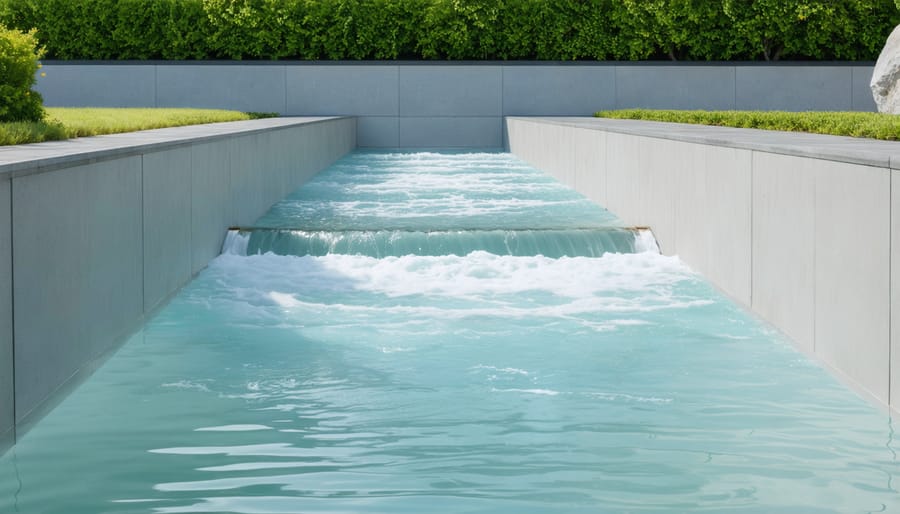
Environmental Impact That Makes a Difference
Installing a graywater recycling system creates ripple effects that extend far beyond your property line. When you divert water from your washing machine, showers, and sinks for reuse, you’re directly reducing the burden on your local municipal water infrastructure. Every gallon of graywater you recycle means one less gallon your city needs to pump, treat, and deliver to your home—and one less gallon of wastewater flowing into overtaxed sewage systems.
This conservation matters especially during peak demand periods when treatment facilities operate at maximum capacity. By cutting your household water consumption by 30-50%, you’re helping prevent the overflow events that can occur when aging municipal systems become overwhelmed during summer months or population growth spurts.
Perhaps more critically, graywater recycling helps preserve underground aquifers that supply drinking water to millions of Americans. These natural water reserves recharge slowly—often taking decades or centuries—yet we’ve been depleting them at unsustainable rates. When you reduce your reliance on freshwater sources, you’re allowing these vital reserves time to replenish naturally.
The energy savings deserve attention too. Municipal water treatment is surprisingly energy-intensive, requiring substantial electricity to pump, filter, disinfect, and transport water across communities. Wastewater treatment demands even more energy to remove contaminants before releasing water back into the environment. By keeping graywater on your property and using it directly, you’re eliminating the energy footprint associated with both processes—a contribution to reducing greenhouse gas emissions that compounds with each household that adopts this cutting-edge water innovation.
What You Can (and Can’t) Do With Recycled Greywater
Safe Uses for Greywater
Greywater isn’t suitable for every application, but when used correctly, it offers numerous practical opportunities to reduce your household’s freshwater consumption. Understanding which uses are safe ensures you’ll maximize your system’s benefits while protecting your family’s health.
**Landscape irrigation** stands as the most common and beneficial greywater application. Water from showers, bathroom sinks, and washing machines works beautifully for watering lawns, ornamental plants, trees, and shrubs. The mild soaps and organic matter actually provide nutrients that help plants thrive. However, avoid using greywater on edible crops that come in contact with the soil, like lettuce or root vegetables—fruit trees and plants where the edible portion grows above ground are generally acceptable.
**Toilet flushing** represents another excellent use, especially in modern greywater systems with proper filtration. Since toilets account for nearly 30% of indoor water use, this application delivers substantial savings while eliminating any health concerns since the water never contacts people or food.
**Car washing** provides a practical outdoor use that conserves drinking water for a task that doesn’t require pristine quality. Similarly, you can safely use greywater for **cleaning outdoor surfaces**, washing sidewalks, or rinsing off outdoor equipment.
Most municipalities prohibit using greywater indoors for purposes beyond toilet flushing, and it should never be used for drinking, cooking, bathing, or watering vegetable gardens with direct soil contact.
What to Avoid: Safety First
While graywater recycling is an excellent sustainable practice, understanding its limitations is crucial for protecting your household’s health and safety. First and foremost, never use graywater for drinking, cooking, or any application involving direct human consumption—this water hasn’t been treated to potable standards and may contain bacteria or contaminants from soaps and personal care products.
Avoid irrigating edible gardens, particularly vegetables that grow in or near the soil, as harmful microorganisms can transfer to food. Root vegetables like carrots and leafy greens are especially risky. Fruit trees are generally acceptable since the edible parts don’t contact the water directly, but always maintain safe distances.
Don’t allow graywater to pool or create standing water, which becomes a breeding ground for mosquitoes and bacteria. Children and pets shouldn’t play in areas where graywater is applied, as direct contact can cause skin irritation or illness. Additionally, never use graywater from kitchen sinks or dishwashers—this “dark graywater” contains food particles, grease, and higher bacterial loads that make it unsuitable even for irrigation.
Finally, avoid storing graywater for extended periods. Use it within 24 hours to prevent bacterial growth and unpleasant odors, keeping your eco-friendly system both safe and effective.
Getting Started: What You Need to Know Before Installing
Local Codes and Permits You’ll Need to Navigate
Before installing a graywater recycling system, you’ll need to understand your local regulations—but don’t let this step intimidate you. Requirements vary significantly by location, with some areas embracing graywater reuse through streamlined permitting while others maintain stricter oversight.
Start by contacting your local building department or environmental health office. Many municipalities now offer dedicated graywater information packets that outline what’s allowed in your area. You’ll typically need to determine whether your planned system qualifies as a simple laundry-to-landscape setup (often requiring minimal or no permits) or a more complex installation that diverts multiple sources and requires professional design review.
Common requirements include minimum setback distances from property lines, wells, and structures, as well as restrictions on which plants can receive graywater. Some jurisdictions require licensed plumbers for installation, while others permit homeowner-built systems if they follow approved guidelines.
To avoid feeling overwhelmed, focus on these three steps: identify your system type, download your local graywater guidelines, and schedule a brief consultation with your permitting office. Many inspectors appreciate proactive homeowners and can provide valuable guidance that simplifies the approval process. Remember, these regulations exist to protect public health and groundwater quality—working within them ensures your eco-friendly upgrade benefits everyone.
Realistic Cost Expectations and Payback Periods
Understanding the financial commitment helps you make an informed decision about greywater recycling. A simple laundry-to-landscape system represents the most affordable entry point, typically costing between $300 to $2,000 for DIY installation or professional setup. These systems can pay for themselves within 2-5 years depending on your water rates and usage patterns.
Mid-range residential greywater systems with basic filtration and pumping capabilities range from $2,000 to $5,000 installed. Expect payback periods of 5-10 years, with average households saving $200-400 annually on water bills. These systems shine in drought-prone areas where water costs continue rising.
Whole-house greywater treatment systems with advanced filtration represent the premium option at $5,000 to $20,000. While the upfront investment is substantial, they process the most water and offer the longest lifespan—often 15-20 years with proper maintenance. Payback periods extend to 10-15 years, but the environmental impact and property value increase make them worthwhile for committed eco-conscious homeowners.
Remember that maintenance costs, local rebates, and your specific water usage significantly affect these timelines. Many municipalities offer incentives that can reduce initial costs by 10-30%, dramatically improving your return on investment.
Maintenance: Less Complicated Than You Think
One of the biggest misconceptions about graywater systems is that they require constant attention or specialized expertise. In reality, modern systems are designed with homeowners in mind, featuring straightforward maintenance routines that take just minutes each month.
Your primary task involves checking and cleaning filters every 4-6 weeks, depending on usage. Most systems use simple mesh or cartridge filters that catch hair, lint, and debris—you simply remove them, rinse under running water, and pop them back in. Think of it like changing your vacuum cleaner bag or cleaning your dryer lint trap. Some cutting-edge water innovations now include self-cleaning filters that reduce this frequency even further.
Every few months, you’ll want to inspect visible pipes and connections for leaks, just as you might check under your kitchen sink. Clear any blockages in distribution lines with a quick flush using clean water.
Annual professional inspections are recommended but not mandatory for most residential systems. During these checkups, a technician ensures pumps are functioning properly and checks water quality levels.
Common troubleshooting is equally manageable. If water flow slows, check filters first—90% of issues stem from clogged filters. Strange odors? Run a cleaning cycle with an eco-friendly solution. Most systems include indicator lights or simple displays that alert you to specific problems, complete with user-friendly solutions in your manual. With this minimal attention, your graywater system will serve you reliably for years.
Choosing the Right Products for Your Greywater System
Selecting the right components for your greywater system ensures reliable performance and longevity. Think of it as assembling a team where each member plays a vital role—choosing quality, compatible parts makes all the difference.
**Filtration Systems**
Your first line of defense is filtration. Look for multi-stage filters that remove lint, hair, soap particles, and food debris. Mesh filters with 200-400 micron ratings work well for basic systems, while sand filters offer superior treatment for more demanding applications. The key is matching filter capacity to your household’s water volume—undersized filters clog frequently, creating maintenance headaches.
**Treatment Components**
Beyond basic filtration, consider biological treatment options like constructed wetlands or aerobic biofilters if you’re treating greywater for landscape irrigation. These systems use natural processes to break down organic matter and reduce pathogens. For simpler setups, UV sterilization units provide an extra safety layer without chemicals, particularly valuable if children or pets access irrigated areas.
**Storage Tanks**
Storage capacity depends on your usage patterns and irrigation needs. Food-grade polyethylene tanks resist corrosion and prevent contamination. Remember that greywater shouldn’t sit longer than 24 hours, so avoid oversizing. Underground tanks save space but complicate maintenance, while above-ground options offer easier access for cleaning. Ensure tanks include overflow protection and proper venting to prevent anaerobic conditions that create unpleasant odors.
**Distribution Equipment**
Quality pumps rated for greywater’s particulate content prevent premature failure. Subsurface drip irrigation systems work beautifully with greywater, protecting plants while minimizing human contact. Diverter valves let you switch between greywater and municipal water during maintenance or when treating water with harsh chemicals.
Consider compatibility with other sustainable practices like rainwater harvesting, creating a comprehensive water conservation approach. Prioritize components with accessible replacement parts and straightforward maintenance procedures—you’re building a long-term solution, not just installing equipment.
Embracing greywater recycling doesn’t require a complete home overhaul or advanced engineering knowledge—it’s a practical, achievable step that everyday homeowners can take toward more sustainable living. Whether you start with a simple laundry-to-landscape system or invest in a comprehensive whole-house solution, you’ll be making a meaningful difference in your household’s water consumption and environmental footprint.
The beauty of greywater systems lies in their flexibility. You can begin with a modest bucket collection method from your shower while you research more permanent installations, or dive straight into a professionally designed system if your budget allows. There’s no single “right” way to recycle greywater—the best approach is one that fits your specific household needs, property layout, and comfort level with DIY projects.
The tangible benefits speak for themselves: reduced water bills, healthier gardens during dry seasons, and the satisfaction of knowing you’re conserving one of our planet’s most precious resources. As water scarcity becomes an increasingly pressing concern, early adopters of greywater technology are positioning themselves ahead of future conservation mandates while enjoying immediate rewards.
Don’t let hesitation hold you back. Start by identifying your household’s largest sources of greywater, research your local regulations, and consider consulting with professionals for guidance. This isn’t just about adopting cutting-edge water innovations—it’s about taking personal responsibility for resource conservation in a way that genuinely makes sense for modern homeowners. Your journey toward sustainable water use can begin today, one load of laundry at a time.
